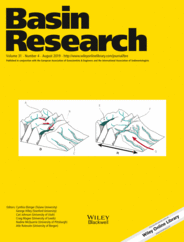
Full text loading...
 , Alexander R. Cruden1
, Alexander R. Cruden1 , Mike Hall1, Steven Micklethwaite1
, Mike Hall1, Steven Micklethwaite1 , Steven W. Denyszyn2
, Steven W. Denyszyn2
Complex arrays of faults in extensional basins are potentially influenced by pre‐existing zones of weakness in the underlying basement, such as faults, shear zones, foliation, and terrane boundaries. Separating the influence of such basement heterogeneities from far‐field tectonics proves to be challenging, especially when the timing and character of deformation cannot be interpreted from seismic reflection data. Here we aim to determine the influence of basement heterogeneities on fault patterns in overlying cover rocks using interpretations of potential field geophysical data and outcrop‐scale observations. We mapped >1 km to meter scale fractures in the western onshore Gippsland Basin of southeast Australia and its underlying basement. Overprinting relationships between fractures and mafic intrusions are used to determine the sequence of faulting and reactivation, beginning with initial Early Cretaceous rifting. Our interpretations are constrained by a new Early Cretaceous U‐Pb zircon isotope dilution thermal ionization mass spectrometry age (116.04 ± 0.15 Ma) for an outcropping subvertical, NNW‐SSE striking dolerite dike hosted in Lower Cretaceous Strzelecki Group sandstone. NW‐SE to NNW‐SSE striking dikes may have signaled the onset of Early Cretaceous rifting along the East Gondwana margin at ca. 105–100 Ma. Our results show that rift faults can be oblique to their expected orientation when pre‐existing basement heterogeneities are present, and they are orthogonal to the extension direction where basement structures are less influential or absent. NE‐SW to ENE‐WSW trending Early Cretaceous rift‐related normal faults traced on unmanned aerial vehicle orthophotos and digital aerial images of outcrops are strongly oblique to the inferred Early Cretaceous N‐S to NNE‐SSW regional extension direction. However, previously mapped rift‐related faults in the offshore Gippsland Basin (to the east of the study area) trend E‐W to WNW‐ESE, consistent with the inferred regional extension direction. This discrepancy is attributed to the influence of NNE‐SSW trending basement faults underneath the onshore part of the basin, which caused local re‐orientation of the Early Cretaceous far‐field stress above the basement during rifting. Two possible mechanisms for inheritance are discussed—reactivation of pre‐existing basement faults or local re‐orientation of extension vectors. Multiple stages of extension with rotated extension vectors are not required to achieve non‐parallel fault sets observed at the rift basin scale. Our findings demonstrate the importance of (1) using integrated, multi‐scale datasets to map faults and (2) mapping basement geology when investigating the structural evolution of an overlying sedimentary basin.

Article metrics loading...

Full text loading...
References


Data & Media loading...

